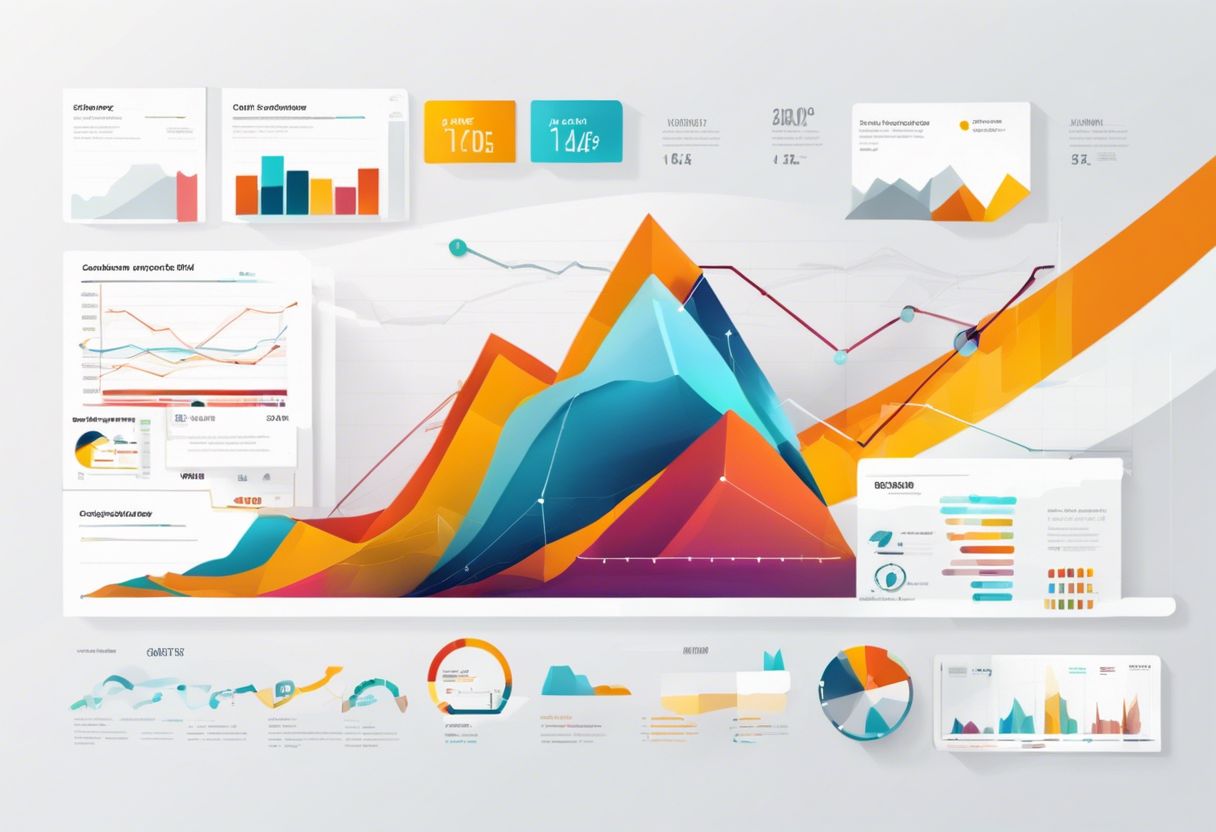Decode Analytics: Understand and Improve Your Website

Hey there, small business owners! Let’s talk about website analytics. This is like a special tool that helps you see how people use your website. It’s important because it shows you what’s working and what needs to get better.
Now, imagine knowing exactly which pages on your site are the most popular. That’s where page views come in; they count when someone looks at a page on your site. And then there’s user engagement – basically how much folks interact with your website.
Also, have you heard of bounce rates? If less than 40% of people leave after only seeing one page, that’s a good sign! It means they like your content enough to stick around. Conversion rates tell us if visitors do what we want them to do, like buy something or sign up for newsletters.
We’ll also show you how to set up Google Analytics—it’s kind of like putting a smart assistant on your site who keeps track of everything for you!
You’ll learn how cool tools called behavior flow and referral reports can help make sense of why people visit and where they come from.
Using all this info can really jazz up your website! You could make changes that help more visitors enjoy their time and even spend money on what you offer.
And here’s the best part: making decisions based on this data can lead to more cash from ads or sales!
So let’s cut through the noise and zoom straight into understanding our websites better with all these nifty tricks up our sleeves! Ready to boost your online game? Keep reading as we dive deeper into making analytics work for us.
Key Website Analytics Metrics Explained

Understanding key website analytics metrics is crucial for improving your website’s performance. From page views and user engagement to bounce rates and conversion rates, analyzing these metrics can provide valuable insights into your website’s effectiveness.
Understanding Page Views and User Engagement

We know keeping an eye on page views is like watching people walk into our store. Each view means someone found a page on our website interesting enough to take a look. It’s important because it shows us what areas of our site get the most interest, just like knowing which shelves in a store are the most popular.
Now let’s talk about how much these visitors dig into what we have to offer – that’s where user engagement comes in. It tells us if they’re just window-shopping or actually trying things out.
If they stay longer, click around, and interact with the content, that’s good news! High user engagement usually leads to better conversion rates, which means more people doing what we want them to do—like buying products or signing up for newsletters.
Keeping track of these metrics helps us make our website even better. We can change things up based on what users like and don’t like. This way, we make sure they have a great experience every time they visit, encouraging them to come back again and again!
Analyzing Bounce Rates and Conversion Rates

Learning about page views and user engagement gives us great insight, but let’s dive deeper into bounce rates and conversion rates to really understand visitor behavior. Bounce rate shows us the percentage of people who leave after looking at just one page on our site.
It’s like knowing how many customers walk into a store then turn around and walk right back out. If we have a lower bounce rate, that means more visitors are sticking around, which is good for business.
To find your site’s bounce rate, you take all the quick exits from a page and divide them by the total visits to that page. If two-thirds of websites have less than 40% bouncing away, we should aim for that too or even better! By keeping an eye on this number, we can work on making our website more interesting so people want to stay longer.
We might need to make sure our pages load fast or put the most important information where it’s easy to see.
Now think about conversion rates – this is when visitors do what we hope they will do on our site, like buy something or sign up for newsletters. A good conversion rate means our website is not only attracting traffic but also encouraging folks to take action which benefits us.
To boost these numbers, we can try different things like putting clear calls-to-action or showing off customer reviews for trust-building.
Both these metrics help us see if our content holds water and matches what users are searching for — key steps in improving SEO performance and ensuring success in the competitive digital space!
Implementing Google Analytics for Data-Driven Decisions

Setting up Google Analytics is crucial for making data-driven decisions. By tracking behavior flow and analyzing referral sources, you can gain valuable insights into your website’s performance and make informed choices to improve user experience and drive conversions.
Setting Up Goals and Tracking Behavior Flow

We all want to know how our website is doing. With Google Analytics, we can see exactly what’s happening and make smart choices.
- Start by thinking about what actions are important for our business. Maybe we want more people to sign up for newsletters or buy products.
- Log into Google Analytics and click on the “Admin” button. In the “View” column, we look for “Goals” and click on it.
- We choose “+ New Goal.” Here, we can pick from templates or create custom goals.
- For a template, select one that matches an action we value, like making a sale or getting a new subscriber.
- If going custom, click “Custom” then “Continue,” and name the goal something clear like “Newsletter Sign-Up.”
- Next, decide how to track the goal. Will it be when someone visits a page, like a thank you page? Or when they stay on our site for a while?
- Enter the details of our goal, such as the URL of that thank you page if it’s a destination goal.
- We can even put a dollar value on each goal completion to see how much money our site might be bringing in.
- Hit “Save” and now Google Analytics will start tracking whenever someone completes that goal.
- Let’s look at Behavior Flow under the “Behavior” section in Google Analytics to see user paths.
- This report shows us where users start and where they drop off or complete our goals.
- With this path analysis, we learn which pages are stars and which ones might need work.
Learning from Referral Sources and Lead Quality

Now that you have a good grasp on setting up goals and tracking behavior flow, it’s time to delve into the world of referral sources and lead quality. Understanding where your website traffic is coming from can give you valuable insights into what’s working well and where there may be room for improvement.
Referral traffic is essential as it can provide your website with a competitive advantage, allowing you to analyze impactful and profitable sources that can boost your business.
Analyzing referral sources through tools like the Referral Report in Google Analytics not only helps in understanding which external websites are sending traffic to yours but also helps in identifying invalid visits, improving the accuracy of your data.
Utilizing Analytics Insights to Optimize Your Website’s Performance

Leveraging the insights gained from website analytics, you can enhance user experience by making data-driven improvements and implementing proven revenue-generating tactics. By understanding user behavior and preferences, you can optimize your website to achieve better performance and results.
Enhancing User Experience Based on Data

Analyzing user engagement data helps us understand how visitors interact with our website. By examining metrics like time on page and click-through rates, we can identify which content resonates most with our audience.
This insight guides us in optimizing our website’s layout and content to meet the needs of our users, ultimately leading to a more satisfying experience.
Examining demographic information from analytics, such as age, gender, and location, enables us to tailor our website to better suit the preferences of different audience segments.
Monetizing Your Website: Proven Revenue-Generating Tactics

After enhancing user experience based on data, small business owners can implement proven revenue-generating tactics to monetize their website effectively. Here are some practical and actionable strategies to optimize website performance and increase online income:
- Implement targeted ad placements and ad spaces to capitalize on valuable traffic monetization without compromising user experience.
- Leverage affiliate marketing programs and sponsored content to diversify revenue streams while providing relevant offerings to the audience.
- Optimize website content for search engines to increase organic traffic, thereby boosting potential ad revenue and maximizing online income.
- Develop premium or subscription – based content offerings to provide exclusive value to loyal visitors, creating a sustainable revenue model for the website.
- Explore e – commerce integration by selling relevant products or services directly through the website, tapping into additional sources of online income.
- Collaborate with complementary businesses for strategic partnerships that can expand reach, enhance brand visibility, and drive mutually beneficial monetization opportunities.
- Utilize email marketing campaigns effectively to engage with visitors, promote products or services, and drive conversions that contribute to overall revenue generation opportunities.
Conclusion

Understanding website analytics is crucial for optimizing your online performance. By decoding data insights, you can enhance user experience, boost SEO, and track the effectiveness of marketing strategies.
Data-driven decisions based on website metrics will help improve site performance and achieve better results. So start decoding your website analytics today to make informed decisions and drive success for your business!
Discover innovative strategies to boost your online earnings by exploring our comprehensive guide on proven revenue-generating tactics for your website.


